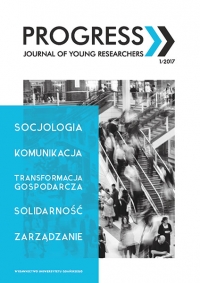DEA Method in Measuring the Efficiency of the Accountancy Offices Employees
Keywords:
efficiency measurement, accountants, accountancy officeAbstract
In the literature there are many methods of measuring the effectiveness of an employee. However the majority of them focuses on the quantitative nature of the work and evaluate it in this sense. In response to the search for a convenient method of analysis of the effectiveness of employees, whose work is qualitative, it has been determined that usage of a method DEA is recommended. Mostly because its measurement should allow the recognition of efficiency in a qualitative way. Based on a study of groups of the accountancy offices from Tricity, an effectiveness scheme analysis of generically similar employees is presented. The inference is based on a innovative survey, which allows evaluation of work for each employee in the sample. The aim of the analysis is the justification for the choice of the DEA method. It is also to show its opportunities with respect to measuring the effectiveness of the accountancy offices employees, as representatives of a group whose work is difficult to measure. The issue of measuring the effectiveness of the accountancy offices encouraged an attempt to identify the characteristics of effective units, which could help to stimulate efficiency features. The conclusions are potentially desirable from the point of view of the employer and could help in the verification at the level of recruitment.
Downloads
References
Aczel A.D., 2000, Statystyka w zarządzaniu. Pełny wykład, tłum. Z. Czerwiński, W. Latusek, Warszawa: Wydawnictwo Naukowe PWN.
Adamiec M., Kożusznik B., 2000, Zarządzanie zasobami ludzkimi, Kraków: AKADE.
Brzeziński J., 2004, Metodologia badań psychologicznych, Warszawa: Wydawnictwo Naukowe PWN.
Ciecieląg J., Pęczkowski M., 2011, Analiza czynnikowa, Analiza głównych składowych, Warszawa: Wydział Nauk Ekonomicznych Uniwersytetu Warszawskiego.
Cooper W.W., Seiford L.M., Tone K., 2007, Data Envelopment Analysis: A Comprehensive Text with Models, Applications, References and DEA-Solver Software, New York: Springer.
Guzik B., 2009, Podstawowe modele DEA w badaniu efektywności gospodarczej i społecznej, Poznań: Wydawnictwo Uniwersytetu Ekonomicznego.
Samuelson P.A., Nordhaus W.D., 2004, Ekonomia, t. 1, tłum. Z. Wolińska, M. Rusiński, Warszawa: Wydawnictwo Naukowe PWN.
Tyrańska M., 2009, Jakość kapitału ludzkiego a efektywność przedsiębiorstwa, „Problemy Jakości”, nr 5.
Ramanathan R., 2003, An Introduction to Data Envelopment Analysis: A Tool for Performance Measurement, New Delhi: Sage Publications.
Varian H.R., 2005, Mikroekonomia. Kurs średni – ujęcie nowoczesne, tłum. S.R. Domański et al., Warszawa: Wydawnictwo Naukowe PWN.
Wieczorkowska G., Wierzbiński J., 2007, Statystyka. Analiza badan społecznych, Warszawa: Scholar.
Downloads
Published
How to Cite
Issue
Section
License
Copyright (c) 2017 Author(s)

This work is licensed under a Creative Commons Attribution 4.0 International License.

 Academic Scientific Journals
Academic Scientific Journals




